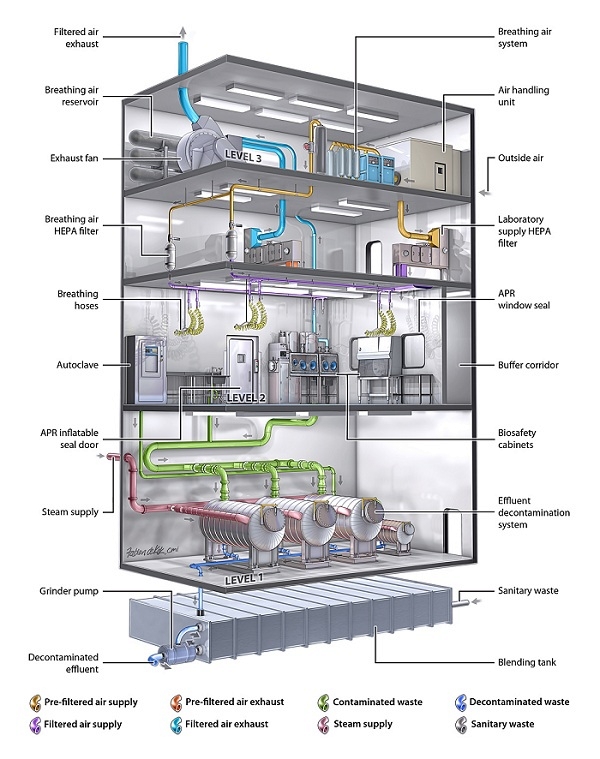Beyond Binary: Biosafety Levels 1 Through 4
Today, while the symbol itself is either absent or present, biohazard safety in labs has evolved beyond a simple yes-or-no labeling system. In the United States, the CDC has established four levels for biosafety and biocontainment, ranging from least to most severe. The lowest level calls for basic precautions, like hand-washing, gloves and common sense. The highest levels necessitate complex sealing and containment protocols. Entrances to such spaces are generally labeled with a biohazard symbol as well as a biosafety level according to their risk.
- Biosafety Level 1 is generally used for agents that will not cause diseases in healthy humans. Labs should be locked and limited, and personnel should generally not consume food or drink inside them. However, the spaces do not need to be systematically isolated.
- Biosafety Level 2 is generally used for agents that may be infectious to humans but difficult to contract in a lab setting. Extra caution is called for when entering, exiting or using sharp objects.
- Biosafety Level 3 is generally used for agents that could cause serious illness or death if inhaled. Protective clothing is required and work is to be done inside biological safety cabinets. Carpets are not permitted and floors, walls, windows and doors should be sealed.
- Biosafety Level 4 is generally used for agents that are not only potentially fatal for humans but that also have no known vaccines or treatments. Highly-trained personnel wear positive pressure suits; any objects or persons entering or exiting are subject to airlock sequences and decontamination procedures.

With these levels of biosafety and associated protections in place, it seems unlikely that researchers will get confused by biohazard stickers on skateboards and sunglasses, no matter how popular the symbol becomes.



Comments (6)
Share
When I was training to be a teacher, I had to take language acquisition classes. One of the classes focused on “Universal Language”. One of the most memorable bits from that class was a story in one of the textbooks about the hollow mountain on Native American land (whose name escapes me now) that is one site of our seriously long term nuclear waste storage. Since the half life of the radioactivity of the stuff is millions of years, the designers of the site needed a symbol that would be recognizable to our MANY times removed grandchildren as marking a very dangerous place. They had to assume the complete collapse of civilization and loss of records in a recognizable or known language that identified the place and its purpose. It had to be universally recognizable as a warning symbol. Sadly, the work was still in development when the textbook was written so I never saw the symbol, but I’ve always been curious as to what they designed.
A couple of years ago, 99PI did an episode about a similar topic, the design of marker systems for the Waste Isolation Pilot Plant (WIPP). You can check it out here, if you haven’t already: http://99percentinvisible.org/episode/ten-thousand-years/
I appreciated the inclusion of three of the other possible biohazard symbols that were considered, but I would really be interested to see ALL of the symbols that were considered. Also, I would be very interested to know about the people who did the design work and thoughts on their design process.
Hi Jeff – I searched for the full symbol set but, alas, was only able to find the few of them you see included in the article. -= Kurt
Thank you for this article. I’m really attracted to images that are graphically elegant, but also present a fearful message. I’ve been working with the biohazard symbol, along with similar graphics, in a series of paintings. You can see this work in my most recent blog post: http://www.studionhr.com/blog/
In my uneducated opinion, they should have sticked with jolly roger. What else could have been better to symbolize death, universally and everlastingly, other than dead remains such as bones and dead flesh?
Also in the case of WIPP nuclear waste. If we were to warn our organic successor in ten of thousand years about the danger of our nuclear waste, dead remains still have the same meaning; death.
Even though in modern times we use jolly roger as accessories, they always mean the same, “I wear jolly roger because I am as deadly as pirates. This place is where we bury treasures, and we put our jolly roger to warn that death comes to those who dare to disturb.”